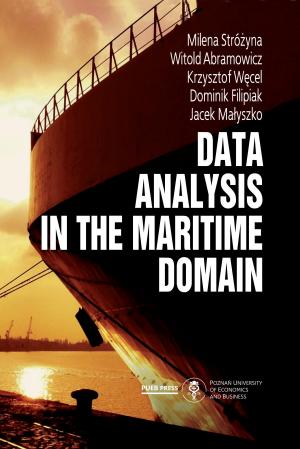
e-ISBN: 978-83-8211-137-8
DOI: 10.18559/978-83-8211-137-8
Edition: I
Publication date: 2022
First publication date: 2022
Pages: 355
Print: paperback
Electronic version: pdf
Format: B5
License : open access
logistics, transport, supply chains, data analysis, risk assessment, global economies
last week: 12
last 3 months: 268
Milena Stróżyna, Witold Abramowicz, Krzysztof Węcel, Dominik Filipiak, Jacek Małyszko
Data analysis in the maritime domain
Availability and purchase
Electronic version(IBUK)Electronic version
(CEEOL)
*Clicking the button takes you to an external open access or selling platform.
The book is available in library subscriptions: Ibuk Libra and EBSCO.
Stróżyna, M., Abramowicz, W., Węcel, K., Filipiak, D. and Małyszko, J. (2022). Data analysis in the maritime domain. Poznań University of Economics and Business Press. https://doi.org/10.18559/978-83-8211-137-8
The book delivers a rich set of foundations, state-of-the-art knowledge, new approaches and methods for the purpose of anomalies detection, maritime traffic analysis as well as risk and reliability assessment. It addresses relevant research problems at the intersection of maritime transport in global economies, reliability and risk assessment, and information systems and data processing.
The book provides a theoretical overview of available maritime data sources and approaches for maritime data analysis, as well as a set of novel tools and methods for maritime data retrieval, fusion, and analysis. The proposed methods are evaluated on real-life AIS data, covering the entire world and more than 200 thousands of vessels, illustrating how they may be used for anomaly detection and risk assessment.
The primary audience of the book are researchers from the fields of computer science and maritime transport as well as logistics service providers, shipping companies and port authorities companies that need support in managing security, safety, and risk of maritime transport services in global economies by making use of large-scale data processing.
Authors affiliation:
Milena Stróżyna, Poznań University of Economics and Business, Poland
Witold Abramowicz, Poznań University of Economics and Business, Poland
Krzysztof Węcel, Poznań University of Economics and Business, Poland
Dominik Filipiak, Poznań University of Economics and Business, Poland
Jacek Małyszko, Poznań University of Economics and Business, Poland
The monograph has been indexed in the Web of Science Book Citation Index.
Chapter 1. Introduction
Chapter 2. Maritime transport and logistic services
2.1. Maritime transport
2.2. Trends and challenges in the maritime domain
2.3. Maritime logistic services
2.3.1. Quality of a maritime logistic service
2.3.2. Reliability of a maritime logistic service
2.4. Actors in the maritime supply chains
2.5. Maritime transport monitoring
Chapter 3. Maritime risk assessment
3.1. Maritime risk and reliability
3.1.1. Risk management
3.1.2. Transport risk
3.1.3. Maritime risk
3.2. Maritime risk assessment systems and methods
3.2.1. Formal safety assessment
3.2.2. Maritime risk assessment approaches
3.2.3. Other methods used in the maritime domain
3.3. Maritime risk variables
3.4. Shortcomings and gaps in the existing risk assessment methods
Chapter 4. Maritime data
4.1. Data sources used in the maritime domain
4.1.1. Sensor data
4.1.2. Weather data
4.1.3. Internet sources
4.2. Maritime data quality
4.3. Data enhancement
4.3.1. Source selection method
4.3.2. Identification
4.3.3. Quality measures
4.3.4. Assessment and selection
4.4. Data extraction
4.4.1. Data fusion and disambiguation
4.4.2. Data processing and analysis
4.5. Maritime data sources—a summary
4.6. System for maritime monitoring—a case study
4.6.1. Outline of the system
4.6.2. Maritime data selection
4.6.3. Data retrieval and disambiguation
Chapter 5. Maritime routing and traffic networks
5.1. Ships routes prediction
5.2. Maritime traffic networks
5.3. HANSA system—a case study
5.3.1. Outline of the system
5.3.2. Method for waypoints generation
5.3.3. Method for traffic patterns and RC extraction
5.3.4. System architecture
Chapter 6. Maritime anomalies detection
6.1. Maritime threats and anomalies
6.2. Typology of maritime anomalies
6.3. Anomalies detection: Approaches, methods
6.4. Loitering-related anomalies detection
6.4.1. Speed anomaly
Chapter 7. Short-term maritime reliability and risk assessment
7.1. Outline of the method
7.2. Risk classifiers and variables
7.2.1. Ship-related classifier
7.2.2. Voyage-related classifier
7.2.3. History-related classifier
7.3. Application of the MMRAM method—an example
7.3.1. Data sources and infrastructure
7.3.2. Analysis results
7.3.3. Ranking of ships
7.3.4. Summary of the results
Chapter 8. Ship’s punctuality prediction
8.1. Outline of the method
8.2. Route prediction
8.3. Travel time profile
8.4. Additional variables
8.4.1. Congestion
8.4.2. Hazard index
8.4.3. Weather and sea state
8.4.4. Past delays
8.5. Determination of ship’s punctuality
8.5.1. Travel time updates
8.5.2. ETA prediction
8.6. Application of the SPP method—an example
8.6.1. Data sources and infrastructure
8.6.2. Analysis results
8.6.3. Congestion results
8.6.4. Hazard results
8.6.5. Delay factor results
8.7. Summary of the results
Chapter 9. Application of big data technologies for maritime data analysis
9.1. Application of big data technologies for maritime anomalies detection
9.1.1. Methodology
9.1.2. Anomaly detection
9.1.3. Traffic analysis
9.1.4. Static anomalies
9.1.5. Loitering detection
9.1.6. Benchmark
9.2. Maritime traffic network analysis
9.2.1. Methodology
9.2.2. CUSUM
9.2.3. Spatial partitioning
9.2.4. Genetic algorithm
9.2.5. AIS enrichment
9.2.6. Reconstruction of edges
9.2.7. Maritime traffic network evaluation
Chapter 10. Summary
Appendix A. Evaluation of the MRRAM method—results
A1. Statistics of accidents for ship types and classification societies
A2. Bayesian Network parameters for the risk classifiers
Appendix B. Evaluation of the SPP method—results
B1. Results of route prediction method
B2. Hazard index—results
References
List of tables
List of figures



 Full text download (pdf)
Full text download (pdf)